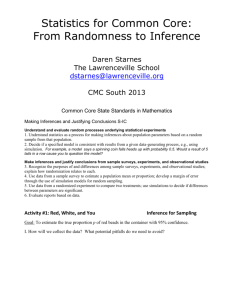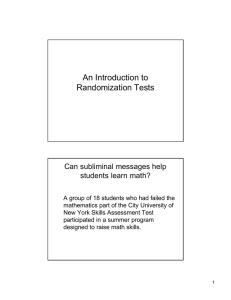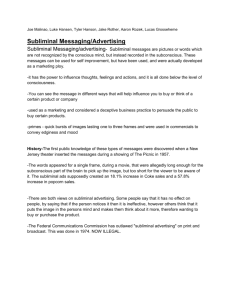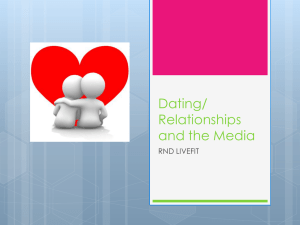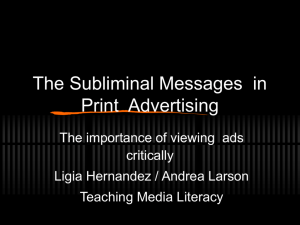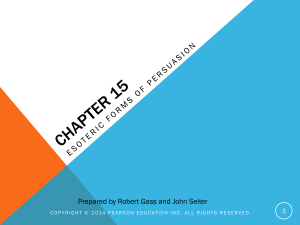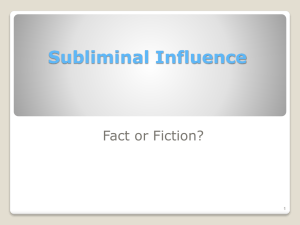Statistics for Common Core 2013 starnes final
advertisement
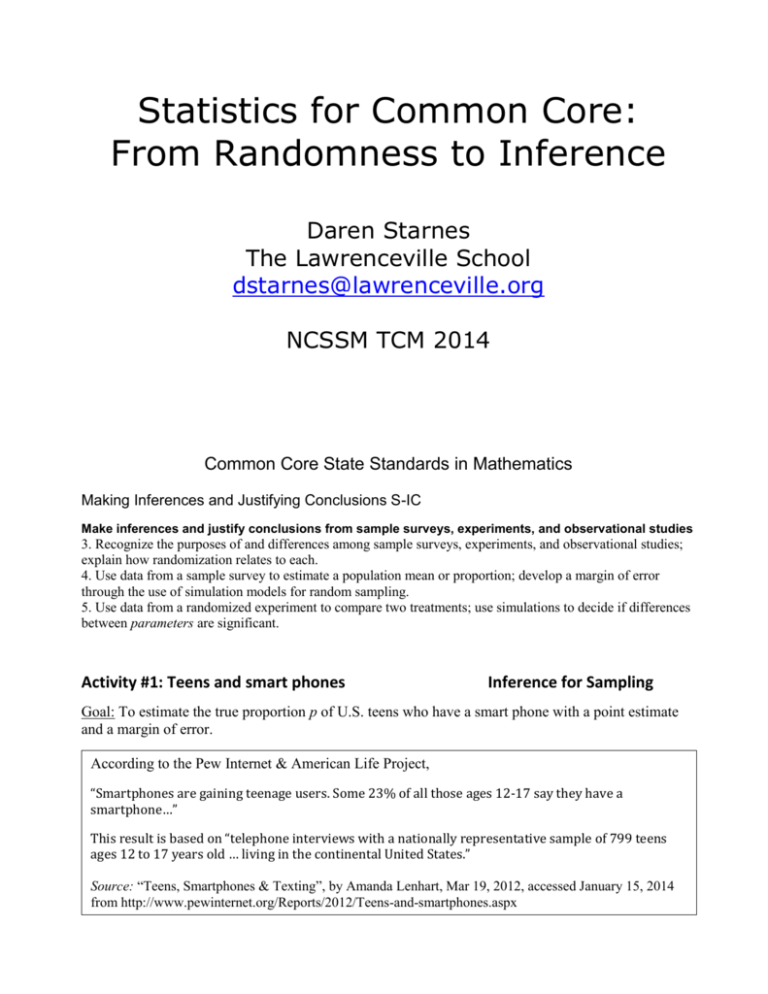
Statistics for Common Core: From Randomness to Inference Daren Starnes The Lawrenceville School dstarnes@lawrenceville.org NCSSM TCM 2014 Common Core State Standards in Mathematics Making Inferences and Justifying Conclusions S-IC Make inferences and justify conclusions from sample surveys, experiments, and observational studies 3. Recognize the purposes of and differences among sample surveys, experiments, and observational studies; explain how randomization relates to each. 4. Use data from a sample survey to estimate a population mean or proportion; develop a margin of error through the use of simulation models for random sampling. 5. Use data from a randomized experiment to compare two treatments; use simulations to decide if differences between parameters are significant. Activity #1: Teens and smart phones Inference for Sampling Goal: To estimate the true proportion p of U.S. teens who have a smart phone with a point estimate and a margin of error. According to the Pew Internet & American Life Project, “Smartphones are gaining teenage users. Some 23% of all those ages 12-17 say they have a smartphone…” This result is based on “telephone interviews with a nationally representative sample of 799 teens ages 12 to 17 years old … living in the continental United States.” Source: “Teens, Smartphones & Texting”, by Amanda Lenhart, Mar 19, 2012, accessed January 15, 2014 from http://www.pewinternet.org/Reports/2012/Teens-and-smartphones.aspx What is our “best guess” at the value of p based on the data? This is our point estimate. How close does the sample result tend to be to the true population value in random samples of this size? In other words, what’s the margin of error for our estimate? To find out, let’s do a calculator simulation. o First, let’s seed our random number generators! Type the 7 digits in your cell phone number, STO to MATH/PRB/rand, and press ENTER. o Let’s assume that the true population proportion is (at least approximately) 0.23. o Use the randInt command to generate 799 values between 1 and 100 and store them in L1/list1. Let values from 1 to 23 represent a teenager who owns a cell phone. Find the proportion of teens in the simulated sample who own a cell phone. o Record your value of the sample proportion p̂ on the poster in front of the room. o Repeat the process if needed. o How would our estimate for the margin of error change if the true population proportion was 0.25? 0.20? Conclusion: Activity #2: Do subliminal messages work? Inference for experiments From The Practice of Statistics, 5th edition, by Starnes, Tabor, Yates, and Moore, W. H. Freeman and Co., 2015. A “subliminal” message is below our threshold of awareness but may nonetheless influence us. Can subliminal messages help students learn math? A group of 18 students who had failed the mathematics part of the City University of New York Skills Assessment Test agreed to participate in a study to find out. All received a daily subliminal message, flashed on a screen too rapidly to be consciously read. The treatment group of 10 students (assigned at random) was exposed to “Each day I am getting better in math.” The control group of 8 students was exposed to a neutral message, “People are walking on the street.” All 18 students participated in a summer program designed to raise their math skills, and all took the assessment test again at the end of the program. The table below gives data on the subjects’ scores before and after the program. Mathematics skills scores before and after a subliminal message Treatment Group Control Group Pre-test Post-test Difference Pre-test Post-test 18 24 6 18 29 18 25 7 24 29 21 33 12 20 24 18 29 11 18 26 18 33 15 24 38 20 36 16 22 27 23 34 11 15 22 23 36 13 19 31 21 34 13 17 27 10 Difference 11 5 4 8 14 5 7 12 Source: Data provided by Warren Page, New York City Technical College, from a study done by John Hudesman. Do the data provide convincing evidence that the subliminal message about getting better at math results in larger increases in scores, on average, than the neutral message? Subliminal Messages Group Diff C T Row Summary 8.25 8 3.69362 11.4 10 3.1693 10 18 3.67823 mean count S3 = stdDev S1 = S2 = Simulation of the random assignment: Question: Based on the data, is it plausible that there’s really no effect of subliminal messages, and random chance alone produced the observed differences between these two groups? Write the 18 difference values on identical slips of paper. Place all 18 slips in a bag and mix them well. If there’s no treatment effect, then pretest scores, posttest scores, and difference values same as in original study. How large a difference in group means with different random assignments? Pull out slips one at a time until you have 10 to represent the Treatment group. The remaining 8 slips represent the Control group. Calculate the difference in mean improvement scores for the two groups (Treatment – Control). Record this value in the table below. Repeat this process two more times. Write your three simulated difference in mean values on the sticky note provided and bring it to the front of the room. Trial Difference in mean improvement scores (T – C) 1 2 3 Combine results: How often did a difference as large as or larger than the one observed in the study (𝑥̅ 𝑇 − 𝑥̅𝐶 = 3.15) occur just due to the chance involved in the random assignment? Computer simulations: www.lock5stat.com/statkey ***************************************************************************************** *****************************************************************************************
